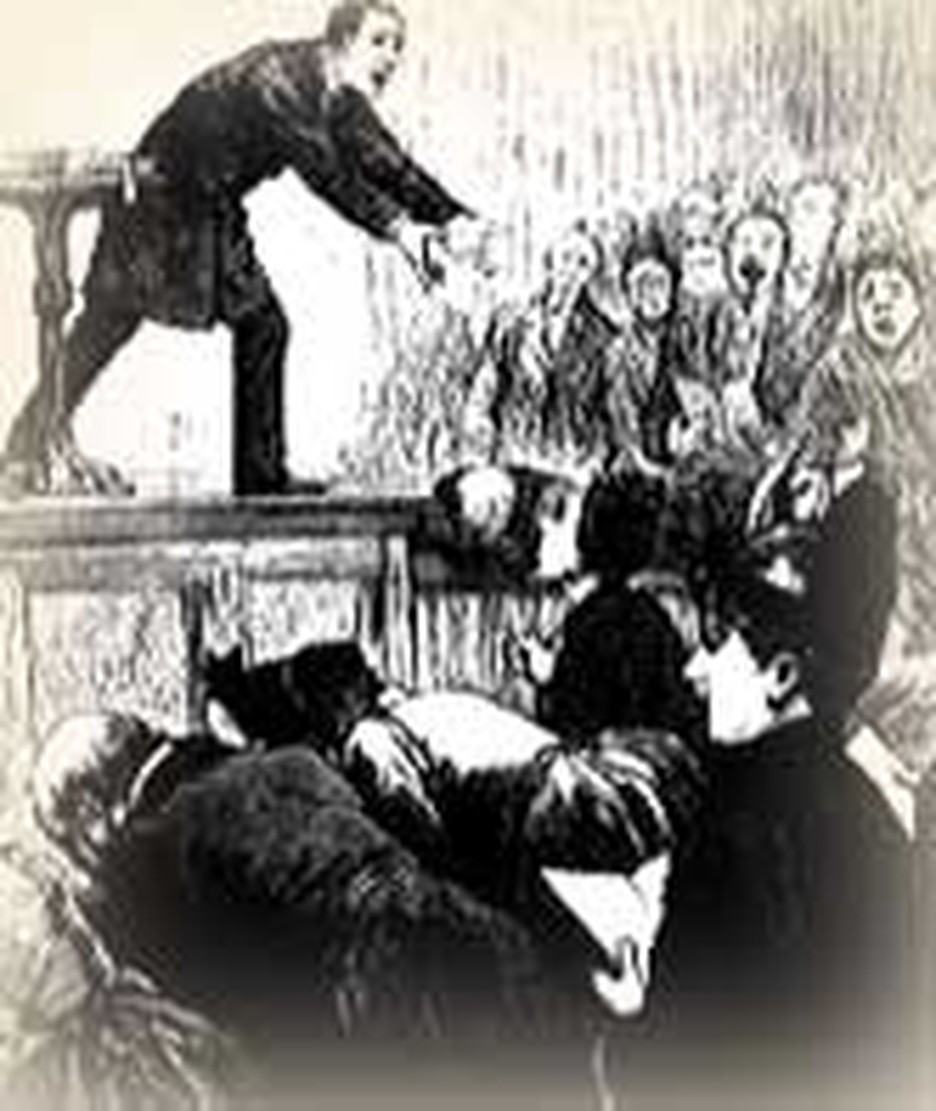
Sometimes it is during the days of hopelessness and despair that revival comes to a people! So it was in the middle of the nineteenth century. In the United States, it was a spiritual, political, and economic low point. Many people had become disillusioned with spiritual things because of preachers who had repeatedly and falsely predicted the end of the world in the 1840's. Agitation over the slavery issue had bred much political unrest, and civil war seemed imminent. A financial panic hit in 1857. Banks failed, railroads were bankrupt, factories closed, unemployment increased. Many Christians realized the need for prayer in such dire situations, and prayer-meetings began to spread around the country.
Ferment from Fulton street
In the lower Manhattan section of New York, a Dutch Reformed church had
been steadily losing members; they hired missionary Jeremiah Lanphier
to reverse the trend with an active visitation program. However, he had
little success in awakening church members by his visits, so in September,
1857, he rented a hall on Fulton street in New York City and advertised
its availability for prayer meetings. Six men assembled for that first
prayer meeting on September 23. Two days later the Bank of Philadelphia
failed. In October the men began praying together daily; on October 10
the stock market crashed. The financial panic triggered a religious awakening,
and people flocked to the prayer meetings. Within six months 10,000 people
were gathering daily for prayer in New York City alone.
The movement explodes
Other cities also were experiencing a renewed interest in prayer. In Chicago,
the Metropolitan Theater was filled every day with 2000 people assembling
for prayer. In Louisville, several thousand came to the Masonic Temple
for prayer each morning. Two thousand assembled for daily prayer in Cleveland,
and the St. Louis churches were filled for months at a time. The newly
formed YMCA also played an important role in holding prayer meetings and
spreading the revival throughout the country.
When media actually helped
In February, 1858, Gordon Bennett of the New York Herald gave extensive
coverage to the prayer meeting revival. Not to be outdone, the New York
Tribune devoted an entire issue in April, 1858 to news of the revival.
News of the revival quickly traveled westward by telegraph. This was the
first revival in which the media played an important role in spreading
the revival.
Prayer everywhere
The prayer meetings were organized in the cities by lay people and were
interdenominational. Unlike earlier awakenings, prayer rather than preaching
was the main instrument of revival. Tents were often set up as places
where people could gather for prayer, introducing a custom followed by
later revivalists. The meetings themselves were very informal -- any person
might pray, exhort, lead in a song, or give a word of testimony, with
a five minute limit placed on each speaker. In spite of the less structured
nature of the prayer meetings, they lacked the extreme emotionalism which
some had criticized in earlier revivals.
America's good gift
This was the first revival beginning in America with a worldwide impact.
From the United States the revival spread to Ireland, Scotland, Wales,
England, Europe, South Africa, India, Australia, and the Pacific islands.
In geographical and proportionate numerical extent, the revival of 1857-1860
has not been equaled.
Even ships coming into British ports told of the revival in America. Ireland soon began to experience a prayer meeting revival as well, with crowds becoming so large they had to meet in the open air. When John Cairns preached in Belfast in May, 1859, he had never before seen such eagerness to hear the gospel or lives which had been so transformed by the revival. He said: "Nature does not contain any epidemic so like to Christian conversion."
Thirst for the Spirit in Scotland
When Andrew Bonar heard of the work in Ireland, he increased his prayer
for a revival in Scotland. In his diary of July 3, 1859, he wrote, "Again
this night in sorrow of heart over the terrible carelessness, indifference,
deadness of this 'valley of dry bones.' O my God, come over to Scotland
and help us!"
Within two months Andrew Bonar found himself in the midst of revival in Scotland. On September 10th he wrote in his diary, "This has been a remarkable week: every day I have heard of some soul saved among us..." All classes became interested in salvation, backsliders returned, conversions increased, and Christians desired a deeper instruction in spiritual truths. Families established daily devotions, and entire communities underwent a noticeable change in morals.
Not celebrities but ordinary people praying
Similar changes were noted as the revival spread to Wales, England, and
beyond. There was an absence of great names connected with the revival;
lay people in prayer were the prime instruments used by God in awakening
the people. The preaching, which in many areas had become too intellectual
and lifeless, now concentrated on the truths of the gospel of Christ and
His cross.
The results of the revival of 1859 in the areas of evangelism, missions, and social action continued for decades. Many who became Christian leaders during the second half of the nineteenth century were greatly affected by the revival-- such as D.L. Moody, William Booth, C.H. Spurgeon, and A.B. Simpson. As James Buchanan of Scotland summarized, it was a time when "new spiritual life was imparted to the dead, and new spiritual health imparted to the living."
Getting a people spiritually ready to face
tragedy? |








